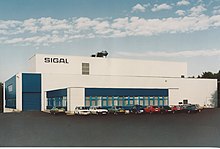Aluminum electrolyte
Aluminum electrolyte is a type of electrolyte used in electroplating .
Separation options
Because of the normal potential of aluminum (−1.64 V versus normal hydrogen electrode ), galvanic deposition from aqueous media is not possible. However, there are the following separation options:
- Aluminum salts in organic solvents
- Fused metal electrolysis of aluminum complexes (this can also include deposition from ionic liquids )
- Organo-aluminum complex electrolytes in organic solvents
Deposition from organoaluminum compounds
To date, aluminum electrolytes are the only commercially used electrolytes that function in aprotic media on the basis of organometallic compounds . Attempts to electrodeposit other base metals from organometallic compounds are only partially successful.
The work of Prof. Karl Ziegler and H. Lehmkuhl in 1954 in Mülheim an der Ruhr was decisive for the galvanic aluminum deposition based on organoaluminum compounds . This process avoids overheating of work hardened areas, as can occur with PVD processes or coatings with ceramic-aluminum stoving enamels. Since work is carried out in non-aqueous media, no hydrogen embrittlement was observed. The disadvantage, however, is the low throwing power of these aluminum electrolytes , which can lead to inadequate coatings on workpieces with complex shapes.
The layers deposited from the electrolyte are comparable to galvanic cadmium layers . The basic materials are protected by breaking down the aluminum layer (chloride ions are obviously necessary to remove the passivation of the aluminum). The corrosion resistance is also determined by the base material. An anodizing sufficiently thick aluminum layers is possible.
This process was patented by Siemens AG in 1973 as the Sigal® process. Active in the field of galvanic aluminum deposition based on organoaluminum compounds are z. B. Messerschmidt-Bölkow-Blohm GmbH MBB , Rasant Alcotec and Aluminal Oberflächentechnik GmbH.
In order to improve the cathodic protection, an electrolyte based on diethyl zinc / triethyl aluminum / sodium fluoride in toluene is proposed (patent application). The disadvantage is the previously short service life of the electrolyte .
Composition of aluminum electrolytes
Because of the sensitivity to hydrolysis and oxidation, it is necessary to work under protective gas .
- version 1
- 267 g of anhydrous aluminum chloride is 188 g in ethylpyridinium dissolved
- make up the mixture to 1 l with toluene
- T = 20-30 ° C
- Efficiency: 85%
- I / A = 1 A / dm²
- Variant 2
- in 1 liter of diethyl ether first 300 g of anhydrous aluminum chloride and then 6 g of lithium hydride dissolved
- the anode compartment is formed by a diaphragm separated
- I / A = 1 A / dm² (in extreme cases up to 10 A / dm²)
- the corresponding magnesium layers can be produced by using magnesium bromide instead of aluminum chloride
- Variation 3
- 30 g of aluminum is in a mixture of 1 ml of bromine , 450 ml of ethyl bromide and 250 ml of benzene dissolved
- Efficiency: 70%
- I / A = 0.9 A / dm2
swell
- Gerd-Bodo Dick, R. Suchentrunk: Future technology aprotic aluminum separation : Review and perspectives . In: Electroplating . tape 95 . Leuze, 2004, ISSN 0016-4232 , p. 1362-1368 ( PDF ).
- Heinz Wilhelm Dettner, Johannes Elze: Manual of electroplating. Volume 2. - Process for galvanic and electroless metal deposition . Hanser, Munich 1966.
- Thomas Walter Jelinek: Practical Electroplating: A teaching and manual . Leuze, Bad Saulgau 2005, ISBN 3-87480-207-8 .
Footnotes and individual references
- ↑ Jürgen Karthaus: Galvanic separation of metals from non-aqueous electrolytes for microsystem technology . University of Karlsruhe, Karlsruhe 2000 (URL: PDF, 2.3 MB - dissertation).
